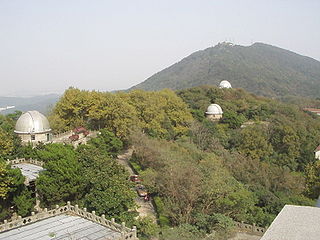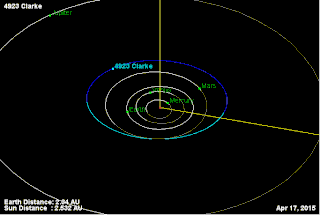J. Duncan Waldron is a Scottish planetarium astronomer, photographer, and discoverer of two minor planets.
Duncan Waldron was born in Glasgow, Scotland. His first job was creating high quality reproductions of astronomical plates for the Royal Observatory in Edinburgh. On 10 October 1986 Waldron discovered the asteroid, 3753 Cruithne, while serving at the UK Schmidt Telescope at Siding Spring Observatory, and on 21 November 1986, also discovered asteroid 5577 Priestley. [1] In 1995, Waldron was first exposed to Paint Shop Pro because of the Observatory's early exploration of digital photography. This software inspired Waldron to manipulate photographs for artistic purposes, creating kaleidoscopic patterns. In 1998, Duncan Waldron and his family moved to New South Wales, Australia.

James Ferguson was a Scottish-born American astronomer and engineer, who made the first discovery of an asteroid from North America.

Johann Palisa was an Austrian astronomer, born in Troppau, Austrian Silesia, now Czech Republic. He was a prolific discoverer of asteroids, discovering 122 in all, from 136 Austria in 1874 to 1073 Gellivara in 1923. Some of his notable discoveries include 153 Hilda, 216 Kleopatra, 243 Ida, 253 Mathilde, 324 Bamberga, and the near-Earth asteroid 719 Albert. Palisa made his discoveries without the aid of photography, and he remains the most successful visual (non-photographic) asteroid discoverer of all time. He was awarded the Valz Prize from the French Academy of Sciences in 1906. The asteroid 914 Palisana, discovered by Max Wolf in 1919, and the lunar crater Palisa were named in his honour.

Maximilian Franz Joseph Cornelius Wolf was a German astronomer and a pioneer in the field of astrophotography. He was the chairman of astronomy at the University of Heidelberg and director of the Heidelberg-Königstuhl State Observatory from 1902 until his death in 1932.
Eric Walter Elst was a Belgian astronomer at the Royal Observatory of Belgium in Uccle and a prolific discoverer of asteroids. The Minor Planet Center ranks him among the top 10 discoverers of minor planets with thousands of discoveries made at ESO's La Silla Observatory in northern Chile and at the Rozhen Observatory in Bulgaria during 1986–2009.

Carl Gustav Witt was a German astronomer and discoverer of two asteroids who worked at the Berlin Urania Observatory, a popular observatory of the Urania astronomical association of Berlin.
Zhang Yuzhe, also known as Yu-Che Chang, was a Chinese astronomer and director of the Purple Mountain Observatory who is widely regarded as the father of modern Chinese astronomy. He studied the light curves of asteroids, and thus their rotation periods. He also researched the variable star CZ Cassiopeiae and the evolution of the orbit of Comet Halley. Zhang discovered 3 comets and is credited under the name Y. C. Chang by the Minor Planet Center for the discovery of one minor planet, the outer main-belt asteroid 3789 Zhongguo.

The Purple Mountain Observatory, also known as Zijinshan Astronomical Observatory is an astronomical observatory located on the Purple Mountain in the east of Nanjing.
Tsutomu Seki is a Japanese amateur astronomer and discoverer of minor planets and comets, born in Kōchi, Japan.
Roy A. Tucker (1951 - 2021) was an American astronomer best known for the co-discovery of near-Earth asteroid 99942 Apophis (formerly known as 2004 MN4) along with David J. Tholen and Fabrizio Bernardi of the University of Hawaii. He was a prolific discoverer of minor planets, credited by the Minor Planet Center with the discovery of 702 numbered minor planets between 1996 and 2010. He also discovered two comets: 328P/LONEOS–Tucker and C/2004 Q1, a Jupiter-family and near-parabolic comet, respectively.
Robert H. McNaught is a Scottish-Australian astronomer at the Research School of Astronomy and Astrophysics of the Australian National University (ANU). He has collaborated with David J. Asher of the Armagh Observatory.
Antonio Vagnozzi is an amateur Italian astronomer and a discoverer of asteroids.
Milan Antal (1935–1999) was a Slovak astronomer.
Marco Cavagna was an Italian amateur astronomer.

4923 Clarke, provisional designation 1981 EO27, is a stony background asteroid from the inner regions of the asteroid belt, approximately 3.5 kilometers (2.2 miles) in diameter. It was discovered on 2 March 1981, by American astronomer Schelte Bus at the Siding Spring Observatory in Australia. The spheroidal S-type asteroid has a rotation period of 3.14 hours. It was named after British science fiction writer Arthur C. Clarke. On the same night, Schelte Bus also discovered 5020 Asimov.
5806 Archieroy, provisional designation 1986 AG1, is a stony Hungaria asteroid from the inner regions of the asteroid belt, approximately 6 kilometers in diameter. It was discovered on 11 January 1986, by American astronomer Edward Bowell at Lowell's Anderson Mesa Station near Flagstaff, Arizona. It is named after Scottish astrophysicist Archie Roy.
5900 Jensen, provisional designation 1986 TL, is a dark Lixiaohua asteroid from the outer regions of the asteroid belt, approximately 19 kilometers in diameter. It was discovered on 3 October 1986, by Danish astronomer Poul Jensen at the Brorfelde Observatory in Denmark. The asteroid was named for the discoverer and his wife Bodil Jensen.
3785 Kitami, provisional designation 1986 WM, is a carbonaceous Themistian asteroid from the outer region of the asteroid belt, approximately 19 kilometers in diameter. The asteroid was discovered by Japanese astronomer Tsutomu Seki at Geisei Observatory on 30 November 1986, and named after the city of Kitami, Japan.
4713 Steel, provisional designation 1989 QL, is a rare-type Hungaria asteroid from the inner regions of the asteroid belt, approximately 6 kilometers in diameter. It was discovered on 26 August 1989, by Scottish–Australian astronomer Robert McNaught at the Siding Spring Observatory in New South Wales, Australia. It was named after astronomer Duncan Steel.
1655 Comas Solà, provisional designation 1929 WG, is a rare-type asteroid from the central region of the asteroid belt, approximately 36 kilometers in diameter. It was discovered on 28 November 1929, by Spanish astronomer of Catalan origin, Josep Comas i Solà at the Fabra Observatory in Barcelona, Spain. It was later named after the discoverer.
Paul Herget was an American astronomer and director of the Cincinnati Observatory, who established the Minor Planet Center after World War II.